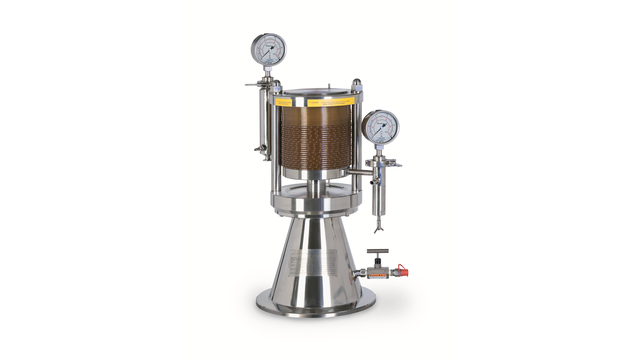LabStak
Alfa Laval offers a wide range of small-scale LabStak modules which are ideal for on-site testing. Valuable data is gained for evaluation of process feasibility, determination of design and up-scaling, optimization of existing production lines or processing of high-value products.
Small-scale LabStak® modules
In order to ensure the optimum solution, it is often advisable to conduct experiments on a small scale. These can be used to establish process feasibility, determine design data for up-scaling, optimize existing production lines or even carry out small-scale processing of high-value and/or low-volume products.
Our range of LabStak® modules is based on the unique plate-and-frame design with the module sizes: M10, M20, M37, M38 and M39. The liquid capacity of our LabStak® modules varies from only 57 ml of test media volume in the Alfa Laval LabStak® M10 module up to 3 litres in the Alfa Laval LabStak® M39H module. It is possible to test all filtration processes: Reverse osmosis, nanofitration, ultrafiltration and microfiltration.
For the Alfa Laval LabStak® M20 module we offer the possibility to test also spiral wound membranes as the module can be equipped with a specially designed M20-2.5" housing. This makes it a perfect tool for initial spiral element testing before screening on flat sheet membranes.
On-site testing or at Alfa Laval pilot facilities
Alfa Laval provides small-scale modules, units and pilot plants for testing on-site in connection with other process equipment and for testing at our own state-of-the-art Membrane and Application Development Test Centre in Nakskov, Denmark. In both cases, we also provide highly skilled process consultancy services.
Benefits
- You can make the first screening evaluations in your own laboratory and thus get the correct answers to vital questions
- The same design is used for both small-scale and industrial scale equipment which allows you to develop new processes and products
- The data gathered is accurate and reliable for easy up-scaling
- Alfa Laval has its own membrane and application development test centre where experts are ready to help you with process know-how and test work
- You can conduct experiments with both plate-and-frame and spiral wound module configurations - and all filtration processes
Hur fungerar membranfiltrering?
Fysisk separering
Membranfiltrering är en fysisk separeringsprocess där drivkraften är skillnaden i tryck mellan de två sidorna av ett speciellt membran. Denna process kännetecknas av förmågan att separera molekyler av olika storlekar och egenskaper.
Nästan all industriell membranfiltrering utförs som korsflödesfiltrering, där vätskan som filtreras flödar parallellt med membranet med hög hastighet och under tryck.
Fysisk barriär
Enkelt förklarat innebär membranfiltrering att en enda matningsström leds genom ett membransystem som separerar den i två individuella strömmar, som kallas permeat och retentat. Membranet som skiljer dem åt är en fysisk barriär med högt specialiserade egenskaper – en barriär som endast vissa utvalda komponenter i matarströmmen kan passera.
Passerar genom
Porerna i ett sådant membranmaterial är så små att de mäts i ångström (10–10 m), och det krävs tryck för att tvinga vätskan genom dem. Faktum är att porerna i membranen som används för nanofiltrering och omvänd osmos är så små att de inte kan ses ens med ett svepelektronmikroskop.
Long experience with membranes
Alfa Laval's experience within membrane filtration dates back almost as far as the technology itself, and we wish to share our experience with you.

